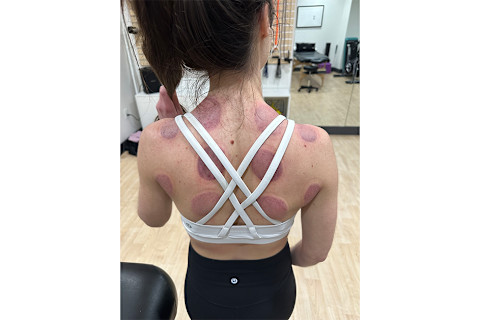The Steps I'm Taking To Relieve Muscle Spasms In My Shoulders & Neck

Relaxed is not a word I reach for when describing myself. Whether I'm trying to sink into a savasana pose or settle into writing an article, letting go of tension has always been a struggle for me. I thought my regular exercise, magnesium supplement before bed, and (of course) working on my mental health were enough to calm my mind and muscles. But I severely underestimated the physical pressure my body was enduring—specifically, my poor shoulders and neck.
I thankfully got a much-needed wake-up call, reset, and action plan to help my angry muscles chill out. And if you often find your shoulders hunched or held toward your ears, these physical-therapist-approved tips are also for you.
What causes tight shoulders?
"One reason someone may feel tight is due to spasm—where muscle tissue has become guarded and unwilling to relax from being overworked," says Joshua Blatt, P.T., DPT, ATC.
Oh boy, did I fall into that category. Years of poor posture (a downside of remote work), inadequate recovery from exercise, and stress had my upper traps and levators (the muscles on the side of the neck) working more than their fair share.
Not only did these areas feel tight, but my range of motion was so restricted that I couldn't move with ease. Blatt also notes that tightness can occur if muscle tissue is not frequently pushed to its full lengthened position, which is more common for folks with sedentary behavior and limited physical activity. So when I did exercise, I likely wasn't getting the most out of my workouts because extending through your full range of motion is essential for building strength and stability.
So it's really a double-edged sword: muscle tightness can limit range of motion and not moving through your full range of motion can lead to tightness.
How to release shoulder tension
These are several at-home stretches and exercises that can relieve tension or even prevent tightness if you do find yourself curled over a desk (like me), slouched in a car, or rigid as a board from stress:
- Side-lying trunk rotations: These are great for targeted back mobility, especially your upper back. "Lie on your side with your knees bent and arms outstretched in front of your body," says Blatt. "Slowly reach your top arm behind you and twist your upper body while rotating along the spine and turn your head with your hand." While you're in this pose, try to relax, breathe gently, and hold for 20-30 seconds. Complete this on each side two to three times at least once a day.
- Shoulder blade squeezes: "First sit or stand with good posture," instructs Blatt. "Then squeeze your shoulder blades back and down (as if you're trying to pinch a pencil) and hold for five seconds, repeating five times." This exercise can be done as many as five times a day. I'm starting with doing it twice a day—one in the morning and one before bed to get in the habit, and will hopefully build on from there.
- Shoulder T's: For this one, you start by holding an elastic band in front of your chest with your arms fully extended (so there's no bend in your elbows). Then, pull your arms apart and toward the side while engaging your shoulder blades back and down. For this exercise, Blatt recommends doing three sets of 10, two or three times a week.
What happens when at-home treatment isn't enough?
If you're feeling chronically tight and no amount of exercise or stretching is taking a load off of your shoulders, other therapies can be incredibly helpful in resetting your baseline.
For me, this included massage and cupping to improve blood flow to the parts of my muscles that were basically locked up. Adequate and efficient blood flow1 is vital to optimal muscle function. Blood carries nutrients and oxygen to tissues and helps sweep metabolic waste (that's detrimental to the muscle) away. So limited blood flow hinders muscle health.
Massage therapy is a compressive technique to manually break up adhesions in the fascia to relieve spasms2. Cupping is a complementary decompression technique.
"The cupping has the same goals as the massage—breaking apart the fascia—but through manipulating the tissue in the opposite way, with suction," says Blatt.

The cups were placed on my muscle trigger points, which tend to be the most bound-down areas in muscular tissue. I was hesitant to give this treatment a go and was (not shockingly) tensing up beforehand at the thought of discomfort. Although I was left with some pretty gnarly scars that lasted for nine days, the cups did effectively vacuum up my muscular mess. Needless to say, I felt a huge wave of relief.
My plan moving forward
Optimizing muscle health has been top of mind for me this year. I upped my protein intake to 100 grams a day.
I also started taking mindbodygreen's creatine with taurine+ to enhance my muscular stores of this energy-supporting compound as well as my mental resilience.* (Ladies, it's one supplement you should definitely consider adding to your routine.)
Now, it's time to add in those daily stretches and exercises to care for my most overworked (and forgotten) muscles.
Tending to these muscles will not only help my posture and improve my range of motion (and therefore my workouts) but also my mood. Turns out, feeling physically relaxed helps me feel mentally relaxed.
The takeaway
Don't shrug off tight shoulders as a passing problem. Because if you do nothing about it, it'll sneakily turn into something long term like it did with me. In these cases, something more drastic—like massage and cupping—can be beneficial to realign the blocked fascia.
Otherwise, taking 10 minutes of your day for movements that counter your typical slouchiness can do wonders in alleviating that tightness or preventing it altogether.

